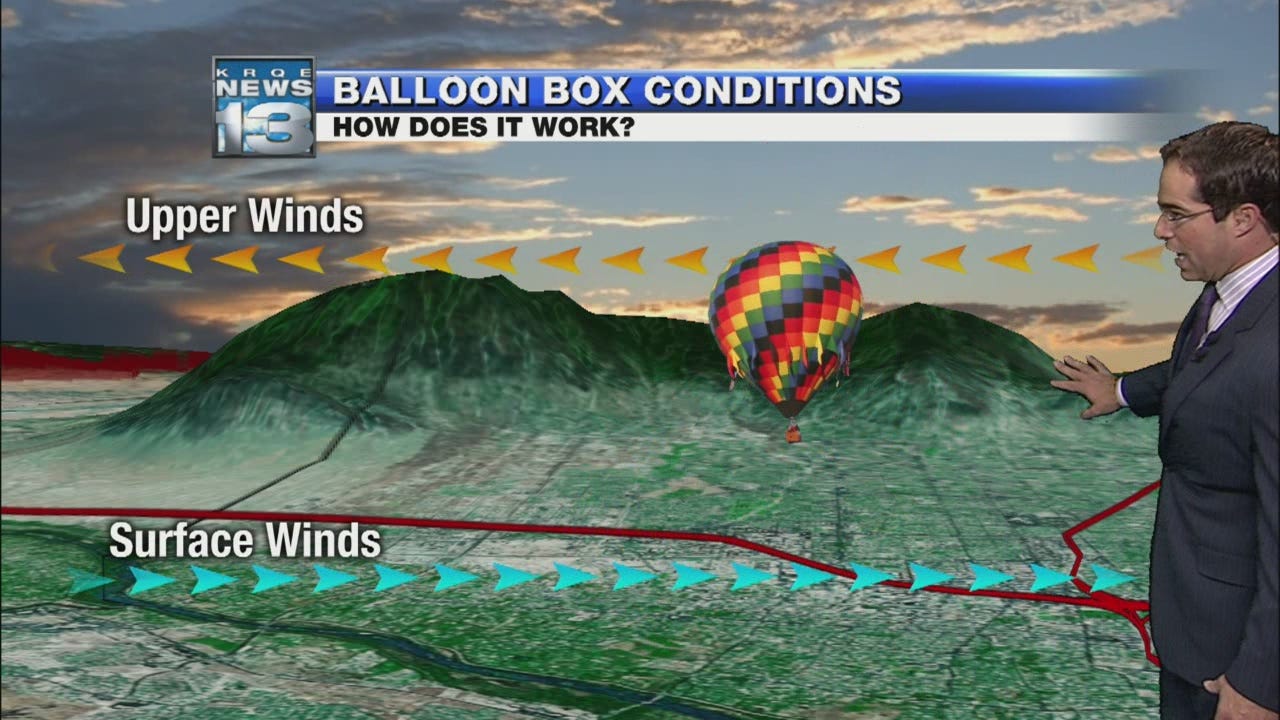The Albuquerque Box: A ballooning blessing and air quality bother
Thanks to its unique climate and wind patterns, Albuquerque draws balloonists and tourists from around the world, but air quality issues remain unsolved.

The Albuquerque International Balloon Fiesta is a must-see event - the largest of its kind. It’s the city’s prime tourist attraction in its 51st glorious year of adding a layer of culture to Albuquerque. Last year’s event attracted an estimated 828,800 people and $203.19 million of economic impact for the city - a highly anticipated boost in revenue for many small-business owners.
Albuquerque’s unique climatology makes it the perfect host for the Balloon Fiesta. The Albuquerque Box, as they call it, relies on a temperature inversion in the atmosphere that allows balloonists to navigate the sky in ways they can’t elsewhere, but that same phenomenon causes air quality issues for the city. Now Albuquerque, a city that used to be known for its great air quality, faces some of the worst air quality in the country.
The same thing that is a blessing for ballooning and the local economy, accentuates pollution from industry and transportation. Businesses, voters, and policy-makers should respond accordingly to ensure the city, its people, and the Balloon Fiesta have a long, sustainable future.
The pros and cons of the box
Albuquerque hosts the world’s largest ballooning event for a reason. The ‘Albuquerque box’ is a uniquely Octoberish airflow pattern that allows balloonists to make a round-trip flight and land at the same place they ascended. Here’s how it works:
At low altitudes, cool morning air flows through the Rio Grande Valley from the North to the South, like a river:

At higher altitudes, warmer, less dense, winds tend to move North this time of year with synoptic patterns in the atmosphere:
And here’s a Ronchetti/KRQE screengrab that illustrates both of these wind elements that power the Albuquerque box:
Balloonists travel South at a lower altitude, then ascend higher when they want to catch the warmer, Northerly, wind back to Balloon Fiesta Park. For the local economy, this phenomenon is a beautiful thing. The millions of dollars that come into the state during Balloon Fiesta can all be traced back to the seasonal wind patterns described above.
The problem is the cool air that sinks down to the Rio Grande Valley floor is also capable of trapping ozone, particulate matter, and other dangerous gas emissions. The City of Albuquerque explains:
A temperature inversion means that temperature is increasing with height… there is an inversion at the interface between the lower layers [of warm and cool air].
Factors that either maintain an inversion or favor the formation of one:
Dry air,
Light or calm winds,
Clear skies at night,
Low sun angle,
Deep, widespread snow cover,
Atmospheric subsidence (a settling or sinking of air)
A temperature inversion at ground level traps smoke and other particulates near the surface causing hazy conditions over Albuquerque.
The trapping of pollutants causes Albuquerque’s infamous “brown cloud.” Temperature inversions form most nights in the Rio Grande Valley during the cooler months.
In the fall, this temperature inversion is met with the Northerly winds that exist above the cool air flow - creating the box.
Historically, Albuquerque had some of the best air quality in the nation, attracting people seeking cleaner air throughout the 20th century. A report by the American Lung Association last year said Albuquerque now has some of the most polluted air in the nation. Increased industry and car emissions have been accentuated by temperature differences - the same mechanisms that makes the box possible in the fall.
This is one of the reasons Albuquerque and Bernalillo County have their own air quality control board, the Albuquerque-Bernalillo County Air Quality Control Board (AQCB). State, local, and federal laws give power to the AQCB to dictate air quality regulations on par, and sometimes completely separate, from the State of New Mexico’s Environmental Improvement Board (EIB).
Most cities throughout the US do not have their own air quality board, but Albuquerque’s unique air quality challenges warrant localized rulemaking capabilities. This makes it so the EIB must pass rules in conjunction with the AQCB when debating rules that affect both jurisdictions - such as with the upcoming rulemaking on Advanced Clean Cars 2 and Advanced Clean Trucks.
But if the AQCB wants to pass its own, more stringent, air quality regulations, such as with Cumulative Impacts, it doesn’t need permission from the EIB.
Air quality in Albuquerque is worst for poor and Hispanic neighborhoods with emissions from transportation and industry disproportionately existing near them. For the Balloon Fiesta, Albuquerque weather patterns are a great thing, but for its residents, the pollution that comes with 828,000 people driving to Balloon Fiesta Park adds to an air quality issue that is only getting worse.

Vehicles contribute large amounts of particulate matter, ozone, and dangerous gases that could be minimized with mass transit and electric vehicles. The EIB and AQCB are looking to mandate more electric vehicles, but the traffic caused by car-centric design is a whole other issue. I pointed this out when I criticized the City of Albuquerque’s decision to (attempt) to put the New Mexico United stadium at Balloon Fiesta Park. This is a car-centric area of the city that fosters traffic and idling cars.
I traveled to the Balloon Fiesta on Monday morning to see the mass ascension. It was a beautiful morning, and the spectacle that is the mass ascension did not disappoint. Balloons speckled across the sky with a backdrop of the Sandias is a spectacle that may never get old. Unfortunately, the armchair urban planner in me saw one issue with the event that has irked me for years - getting in and out of Balloon Fiesta Park is a nightmare.
It took us about 55 minutes to get from the Paseo del Norte I-25 exit until we were walking into the park, and almost as long to get out. The surrounding industrial and manufacturing neighborhoods are not suited for a mass intrusion of cars like during the Balloon Fiesta. I was kicking myself as cyclists passed us by on Alameda as we sat in traffic - we should have ridden our bikes and utilized the bike valet at Balloon Fiesta Park.
With the current prospects of the New Mexico United stadium going to Balloon Fiesta Park, it would really make sense for the city to fix this issue with better transit infrastructure to the area. Adding more lanes would work temporarily to ease traffic issues, but eventually, traffic demands scale up and we’d be back in the same situation. Rail and bus infrastructure, on the other hand, would be more efficient and scalable for delivering large amounts of people to the park. It would also keep all of those car emissions from getting trapped in our breathing and ballooning air.
The city could do a couple of things that ease this issue for future travelers to the Balloon Fiesta and NM United games. They could add a rail spur that extends from the Rail Runner line 425 meters away to the northern area of the park, which would allow everyone from Santa Fe to Belen to park at their local Rail Runner station and ride into the park with ease. Outside of that, there needs to be better bus coverage. That’s likely going to require higher pay for bus drivers in order to fill empty driver seats. Development in and around Balloon Fiesta Park is only going to increase, and in order to allow denser, more efficient, development, the city needs to think outside the car-emission-filled box.
The Balloon Fiesta is a blessing, but emissions in our air are not. As our climate continues to change, it’s hard to tell how or if our local weather patterns will change. Albuquerque finds itself in the middle of the climate fight - the weather pattern we desperately need to boost the economy also punishes us for emitting toxins into the air. Albuquerque has lost its mosquito-less charm, it’s heading towards losing its four-season climate, and it’s bound to lose a lot more as the climate changes.
We’ve already been abusing it, but let’s stop monkeying around before we lose our Albuquerque box too.
This post is brought to you by Barelas Art Company
On a lighter note, I have an exciting announcement to make. To celebrate the Balloon Fiesta in a fun way, Complex Effects is partnering with my other side project, Barelas Art Company, to bring you fun new Complex Effects merch. Shop the Albuquerque International Baboon Fiesta X Complex Effects Mug below!





